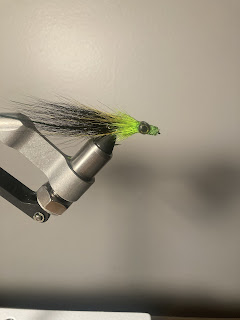Tying an ep hybrid baitfish
This is another fly I came up with recently to target bass in the spring and summertime. It is similar to a jerk fly but it is also very much like a bulkhead fly. The combination of the two techniques makes for great action and the ep fibers add a little bit of suspending time in the water. You can modify this fly to be a jerk fly by simply not tying in the stacks of ep fibers on the side and adding more onto the top. This fly does take a while to get trimmed if you don’t get your ep fiber stacks tapered well enough but it’s definitely worth it.
Materials needed:
Thread
Bucktail
Flash
Ep fibers
Eyes
Streamer hook or weedless hook(I used the pr378 from Ahrex for this fly)
Step 1: start your thread anywhere you want on the hook and make a small thread base. Follow this step by tying in a sparse stack of bucktail and use your thumb to push the bucktail around the hook evenly
Step 2: v-tie in a small stack of ep fibers on top of the bucktail. This should reach out to just shy of the bucktail tips. You’ll want to keep this stack super sparse so that you can build the right tear drop shape of a baitfish by slowly using more ep fibers and making the stacks closer together as you progress up the hook
Step 3: tie in your flash of choice on the side of the fly. I used 2 strands of flashabou for this fly because I don’t want it to be super flashy but you can use whatever amount works best for you
Step 4: move your thread up the shank and tie in stacks of ep fibers on all 4 sides of the hook. You’ll want to do a v tie on the bottom of the hook instead of tying in the fiber like you do on the top and sides. You’ll see what I’m talking about in the picture. Make sure you use more ep fibers on top and less on the sides. Also tie in the stacks with longer fibers pointing rearward than sticking out in front to make it taper better. When you prepare your stacks add taper to the fibers before tying them in. This might not seem like much but it makes a huge difference in the way your fly will come out. It will still need trimming but not as much
Step 6: repeat the last step but use more fibers and still follow the same rules(more on top less on the sides and v tie the bottom stack before reversing the rest of them) I changed the color on the top and on the rest of the stacks in the next few steps to add some contrast but this isn’t required for the pattern
Step 7: repeat the last step until you get to the hook eye and continue to use the same rules as you did in step 5 and 6. As you move up the hook make your stacks closer together to produce a tapered fly. Also at this point you can start tying in a bottom stack just like the ones on the sides and top of the hook. This will help add bulk to the head of the fly. Just remember to use less on the bottom. In this step you’ll want to whip finish and comb the fly out. You can then sweep all of the fibers back into the resting shape of the fly and start trimming a round body. Make sure you don’t take any off of the head but instead just round it out with steep cuts until it is round and it tapers back to the bucktail tail. This might take a while to get perfect but just keep trimming until you feel it’s the best you can trim it to
Step 8: add eyes and the final cuts to finish off the fly. When you glue on the eyes look at them before pressing them down and make sure that they are even with each other. The fly is now ready to fish
This fly is best fished with short steady strips and the occasional pause. I would also reccomend fishing this fly on a sinking line to help it get down in the water column but it’s not impossible to fish it in a floating line
If you liked this post please consider checking out our other posts












Comments
Post a Comment